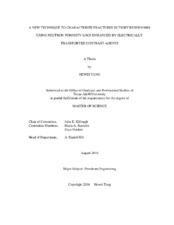| dc.description.abstract | In situ evaluation of fracture density has always been challenging for the petroleum industry, although it is required for a reliable reservoir characterization. Production can be directly controlled by induced and natural fracture density, especially in tight reservoirs. A previous publication introduced a method of using high thermal neutron capture cross-section contrast agents such as boron carbide to enhance the sensitivity of neutron logs to the presence of fractures. However, due to the transport limitations, all of the previous studies are focused on locating the proppants. The possibility of utilizing this method to characterize the fracture density in un-propped area has not yet been investigated. In this paper, we propose a new technique of applying electrical potential to enhance the transport of these contrast agents into induced and natural fractures. The boron carbide contrast agents, if well distributed in natural fractures, will enhance the sensitivity of nuclear logs (e.g., neutron porosity logs) to the presence and density of fractures.
To fulfill the aforementioned objectives, we numerically estimated electric field potential and simulated fluid flow in the fractured formations. The spatial distribution of contrast agents transported using the electrical field potential is then estimated by numerically solving the governing equations derived from electrophoretic velocity and material balance formulations. Furthermore, we simulated neutron porosity logs by solving neutron diffusion equations, which significantly reduces (from hours to few seconds) the computing cost compared to conventional use of MCNP (Monte Carlo N-Particle Code) technique.
The simulation results confirmed that an external electric field can significantly expedite the transport of charged contrast agents in the fracture network. Sensitivity analysis revealed that increasing particle zeta potential can efficiently decrease the transport time. Single fracture model was compared to previously published results obtained from MCNP, which confirmed the accuracy of the method and the effectiveness of baron carbide contrast agents in enhancing the neutron porosity logs. In the presence of 1wt% contrast agents, the minimum fracture width that can be directly detected is 0.01cm. This limit decreases, if the concentration of contrast agents increases. Furthermore, complex fracture models were presented with different secondary fracture density ranging from 1% to 8% and a single hydraulic fracture functioned as the source of the contrast agents. The relative change of simulated neutron porosity before and after applying electric potential field was calculated and compared at different transport time. The favorable detection time to quantify fracture density in the case was also determined. In conclusion, we demonstrated that the new technique enables the successful application of neutron porosity logs in fracture characterization including assessment of secondary fracture density, if combined with other logging tools. | en |


